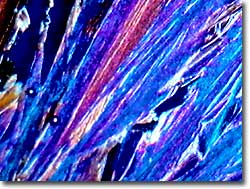Chemical Crystal Movie Gallery
Acetylcholine Chloride Time Lapse Sequences
This chloride salt of acetylcholine is a synthetic version of the central and peripheral neurotransmitter, but is used also as a vasodilator and cardiovascular agent. Available via prescription, acetylcholine chloride is used to keep eye pupils dilated during eye surgery and as a bathing solution for the eyes.

Alternatively known as 2-acetoxyethyltrimethylammonium chloride to biochemists or by the trade name miochol to ophthalmologists, acetylcholine chloride (ACC) forms a white crystal or crystalline powder that is very soluble in water, freely soluble in ethanol, and practically insoluble in ether. The melting point ranges from 149 to 152 degrees Celsius, and in solution, the pH is moderately acidic between 4.0 and 5.7. Featuring 7 carbon, 16 hydrogen, 1 chlorine, 1 nitrogen, and 2 oxygen atoms per molecule, the molecular weight of acetylcholine chloride is 181.66. When reformed from the melt, this organic chemical will slowly recrystallize, forming dendritic, needle-like crystals.
Acetylcholine chloride solution is utilized in cataract surgery and penetrating keratoplasty. Administered by intraocular irrigation, acetylcholine chloride promotes rapid and complete miosis, or constriction of the pupil of the eye. It is also employed as a pharmaceutical raw material for creating other prescription drugs. In the laboratory, acetylcholine chloride can be synthesized from trimethylame and beta-chloroethyl acetate. The synthesized, purified, and stabilized form of acetylcholine is used for clinical research on Alzheimer's disease, in which an impaired acetylcholine balance is implicated. Holistic health practitioners prescribe acetylcholine chloride as a remedy for chest congestion, indigestion, drowsiness, headaches, general fatigue, and forgetfulness.
Acetylcholine Chloride Time Lapse Sequence #1 - A time-lapse sequence of 38 images illustrating dendritic crystal growth starting at the lower left-hand corner of the viewfield and proceeding to the upper right-hand corner to form a confluent texture.
Acetylcholine Chloride Time Lapse Sequence #2 - This 26-image sequence illustrates the growth of predominantly blue dendritic crystals beginning at the upper right-hand corner and continuing toward the lower left-hand corner of the viewfield.
Acetylcholine Chloride Time Lapse Sequence #3 - Vivid blue and violet crystal growth is shown proceeding from the lower left to upper right corners of the viewfield in this time-lapse sequence of 33 images.
Acetylcholine Chloride Time Lapse Sequence #4 - Two confluent sheet-like crystal masses meet as they advance diagonally across the viewfield in a 25-image time-lapse sequence.
Contributing Authors
Omar Alvarado, Thomas J. Fellers and Michael W. Davidson - National High Magnetic Field Laboratory, 1800 East Paul Dirac Dr., The Florida State University, Tallahassee, Florida, 32310.
BACK TO THE CHEMICAL CRYSTAL MOVIE GALLERY
BACK TO THE DIGITAL IMAGE GALLERIES
Questions or comments? Send us an email.
© 1995-2025 by Michael W. Davidson and The Florida State University. All Rights Reserved. No images, graphics, software, scripts, or applets may be reproduced or used in any manner without permission from the copyright holders. Use of this website means you agree to all of the Legal Terms and Conditions set forth by the owners.
This website is maintained by our
Graphics & Web Programming Team
in collaboration with Optical Microscopy at the
National High Magnetic Field Laboratory.
Last Modification Friday, Nov 13, 2015 at 01:19 PM
Access Count Since September 17, 2002: 23880
Visit the website of our partner in introductory microscopy education:
|
|
